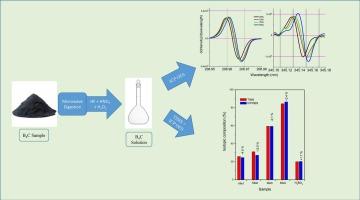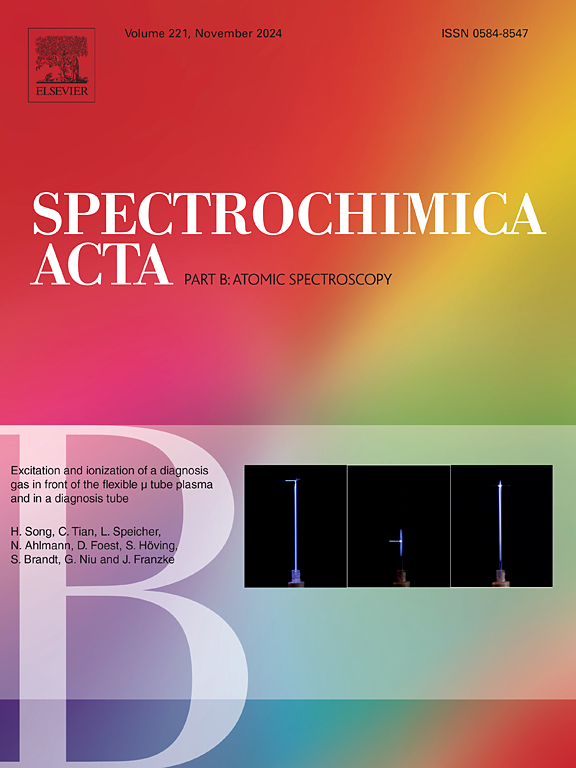电感耦合等离子体发射光谱法测定碳化硼中硼同位素组成
IF 3.8
2区 化学
Q1 SPECTROSCOPY
引用次数: 0
摘要
本文建立了一种利用电感耦合等离子体发射光谱(ICP-OES)测定碳化硼(B4C)中硼(10B/11B)同位素组成的新方法。用BII原子线和BII离子线分别在208.96 nm和345.13 nm处的峰值强度得到校准曲线。两条谱线的峰值强度与同位素组成在10B的20 - 95%范围内呈良好的线性关系(R2 > 0.995)。此外,用峰值一阶导数得到的校准曲线比用峰值得到的校准曲线更灵敏。345.13 nm处的峰移灵敏度是208.96 nm处的近4倍,因此在345.13 nm处获得的校准图用于分析目的。该方法成功地应用于四种合成混合物和一种硼酸样品的同位素组成估计。结果与热电离质谱仪(TIMS)测定结果比较,两者吻合较好。本研究采用的ICP-OES法测定硼同位素组成具有地方性、经济性、快速性和精确性。本文章由计算机程序翻译,如有差异,请以英文原文为准。

Determination of boron isotopic composition in boron carbide using Inductively Coupled Plasma Optical Emission Spectroscopy (ICP-OES)
In the present work, a simple and novel method has been developed to determine the isotopic composition of boron (10B/11B) in boron carbide (B4C) by using Inductively Coupled Plasma Optical Emission Spectroscopy (ICP-OES). Peak intensities of BI atomic line and BII ionic line at 208.96 nm and 345.13 nm, respectively, are used to obtain calibration curves. The intensities of peak maxima of both lines are found to execute excellent linearity (R2 > 0.995) with isotopic composition over the range 20–95 % of 10B. Further, it has been shown that calibration curves obtained from the first derivative of peak maxima are more sensitive compared to the one obtained using peak maxima. Peak shift at 345.13 nm is nearly four times more sensitive than that of 208.96 nm and so calibration plot obtained at 345.13 nm is used for analytical purpose. This method is successfully applied for estimation of isotopic composition in four synthetic mixtures and one boric acid sample. The results are compared with the values obtained by Thermal Ionization Mass Spectrometer (TIMS) and found to have a good agreement between the two techniques. The present ICP-OES method for the determination of boron isotopic composition employed here is proved to be indigenous, economical, rapid and precise.
求助全文
通过发布文献求助,成功后即可免费获取论文全文。
去求助
来源期刊
CiteScore
6.10
自引率
12.10%
发文量
173
审稿时长
81 days
期刊介绍:
Spectrochimica Acta Part B: Atomic Spectroscopy, is intended for the rapid publication of both original work and reviews in the following fields:
Atomic Emission (AES), Atomic Absorption (AAS) and Atomic Fluorescence (AFS) spectroscopy;
Mass Spectrometry (MS) for inorganic analysis covering Spark Source (SS-MS), Inductively Coupled Plasma (ICP-MS), Glow Discharge (GD-MS), and Secondary Ion Mass Spectrometry (SIMS).
Laser induced atomic spectroscopy for inorganic analysis, including non-linear optical laser spectroscopy, covering Laser Enhanced Ionization (LEI), Laser Induced Fluorescence (LIF), Resonance Ionization Spectroscopy (RIS) and Resonance Ionization Mass Spectrometry (RIMS); Laser Induced Breakdown Spectroscopy (LIBS); Cavity Ringdown Spectroscopy (CRDS), Laser Ablation Inductively Coupled Plasma Atomic Emission Spectroscopy (LA-ICP-AES) and Laser Ablation Inductively Coupled Plasma Mass Spectrometry (LA-ICP-MS).
X-ray spectrometry, X-ray Optics and Microanalysis, including X-ray fluorescence spectrometry (XRF) and related techniques, in particular Total-reflection X-ray Fluorescence Spectrometry (TXRF), and Synchrotron Radiation-excited Total reflection XRF (SR-TXRF).
Manuscripts dealing with (i) fundamentals, (ii) methodology development, (iii)instrumentation, and (iv) applications, can be submitted for publication.

 求助内容:
求助内容: 应助结果提醒方式:
应助结果提醒方式:


